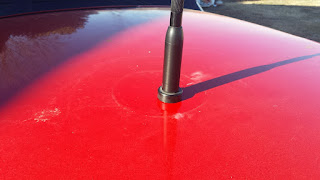... nope, sorry, no room.
So, I got another project anyway. Well, not so much a project as a gateway to projects.
This is the NooElec NESDR, an RTL2832U based SDR (software defined receiver)... module, I guess. Calling it an SDR receiver is technically redundant.
I am interested in SDR in general but what made me jump on this one was that it came with spectrum analyzer software, specifically
Touchstone Pro. More precisely, it came with the license to unlock the free downloadable software.
Installation is a fairly simple affair, but definitely follow the directions. The device needs to be physically present for the driver installation to work right. Furthermore, I found that I could plug it in to a USB3 slot on my laptop and it was discovered, but it would not operate there. I had to move it to another port. This is not the first time I have had trouble getting hardware to operate in that port, though. What tripped me up the worst is that the directions say that the first time the software runs, it will ask for the license key, but mine didn't ask. It just kept going into demo mode. That turned out to be because with the hardware in the USB3 port, the driver was not loaded. Once I moved the dongle to another port, it asked me for the license info and works correctly now.
My initial review of the software is not exactly raving praise, but I will work with it a bit before I am too hard on it. My first complaint is that it doesn't seem to let me scan only a 4 MHz chunk of 2m bandwidth. I can't initially configure it to scan 144 to 148 MHz; it kicked it back saying it had to be minimum 10MHz bandwidth. I had to set it to run 144 to 154, then use the zoom feature to zoom in on desired band. Then, it would show bandwidth to be approximately 4 MHz. Don't forget and try to zoom twice, though; it will crash.
By default, it has a peak hold display enabled. It is implemented as a red trace *in front of* the live green trace. To turn that off, you right click on the screen then toggle a checkbox. However, doing that while it was actively scanning usually, but not always, made the menu hang. You can't turn it off before you begin scanning because the toggle isn't on the menu at that point.
To be fair, I spent a total of about 30 minutes playing with it between tasks at work, so there may be some basic configuration that I can do to avoid these pitfalls, such as the default bandwidth limits and the peak hold feature.
The other thing was an issue I kind of expected. The SDR is sensitive enough that transmitting nearby with my Icom ID-51, even on the lowest power, completely swamped it. It could see the .33 repeater tail with that tiny antenna from inside a concrete building, so even 100mW in the same room was way too much for it.
I am quite intrigued, though. I hope to use SDR technology to explore the RF world around me.








